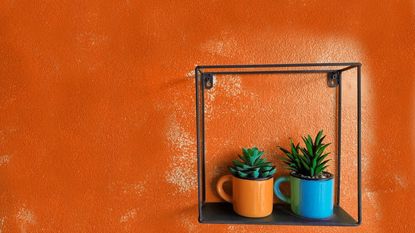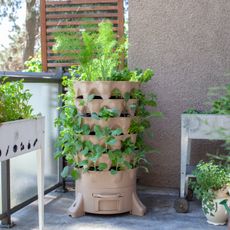What Wall Color Looks Best With Plants?
As a committed plant parent you may wonder what wall color looks best with plants. The right wall color can set off your plants to the best effect, leaving them the stars of the show.


Paint is the basis of any room and can turn drab into fab with some brushes and rollers.
Somebody once said, “image is everything.” With our home decor, we like things to look nice and appealing to our eyes. Your throw pillow colors might harmonize with the couch, so shouldn’t your plants and wall colors complement each other?
Home decor is very subjective. What works for one person may not work for another, but certain decorating rules work for nearly everyone. Most people like a light colored ceiling which raises the height and makes the room look more open. In the same way, the ceiling color can create a sensation, the wall color can contribute to a sense.
Houseplants and room colors don’t have to compete with each other. The paint color could be in harmony with the plants for a sense of calm, or be the foil for the plants, bringing a jungle vibe. Earth tones are the easiest pairing for a natural feel. It's really up to you when pairing your walls with the best houseplants for decor.
Color and Its Role in Home Decor

Color has been shown to evoke a psychological response in humans. This response can vary in many ways and the use of color in home decor can impact our mental state. So color is very important when making a home. We want our homes to feel cozy, comfortable, and peaceful. The living presence of plants should add to our psychological response.
Utilizing color can change the perception and shape of a room and its feel. When holistically applied, color will reshape the effect of a room and when plants are involved, can bring the outdoors inside.
Color Schemes

Depending upon the effect you are desiring, there are several different basic color schemes to consider.
Gardening tips, videos, info and more delivered right to your inbox!
Sign up for the Gardening Know How newsletter today and receive a free download of our most popular eBook "How to Grow Delicious Tomatoes."
- The monochromatic scheme is based on one color and its varying hues. It provides a peaceful cohesive effect.
- The primary color scheme focuses on the core colors of red, blue, and yellow. Such a combination brings energy to the home.
- Analogous colors are those that are next to each other on a color wheel. Such combinations can bring warmth or coolness to a room.
- Pastels work nicely with cool plants with silver or gray leaves.
- Riotous color schemes depend upon all the colors on the wheel and can be chaotic but also joyous.
- The complementary color scheme is very commonly used. It combines colors from the opposite side of the color wheel and enhances the opposing color.
What Paint Color Makes Plants Pop?

If the goal is to make the plants the focal point of the room, color selection can help. Depending on what types of plants are in your collection, the color scheme could be any of the above. But if you are working with only foliage houseplants, adding some color to the room will liven things up.
Utilizing the complementary scheme would see you painting in oranges, but if you use the monochromatic scheme, you would have hues of green. Neither seems quite right for the home interior. Instead, perhaps use another concept, neutrals. Neutrals or earth tones can make the rest of the room blend while allowing the greens of the plants to stand out. Earth tones especially, will offer undertones of brown, pink, and orange. Consider how a terra cotta pot looks with a green leafy plant. The orange earth tone complements and enhances the flora.
Color to Create a Theme
Color also can be used in a thematic room. The jungle vibe would thrive with riotous color. A beachy or seaside concept would be perfect with hues of blue and pink. If you want the room to represent a quiet, forest retreat, earth tones will get you there. A home with a collection of succulents would benefit from neutral hues or complementary colors. If you have a theme but are skittish about using bright wall paint, bring the look together with wall hangings, throw pillows, floor rugs, and paintings.

Bonnie Grant is a professional landscaper with a Certification in Urban Gardening. She has been gardening and writing for 15 years. A former professional chef, she has a passion for edible landscaping.
-
 Clever Vertical Vegetable Garden Ideas For Small Spaces – 7 Ways To Save Space
Clever Vertical Vegetable Garden Ideas For Small Spaces – 7 Ways To Save SpaceShort on garden space? Learn some vegetable garden ideas for small spaces that are fun and easy.
By Mary Ellen Ellis
-
 26 Different Types Of Orchids – With Pictures & Information
26 Different Types Of Orchids – With Pictures & InformationDiscover stunning orchid types to grow in your home and garden – from easy beginner varieties to rare and exotic species that are the preserve of experts.
By Melanie Griffiths